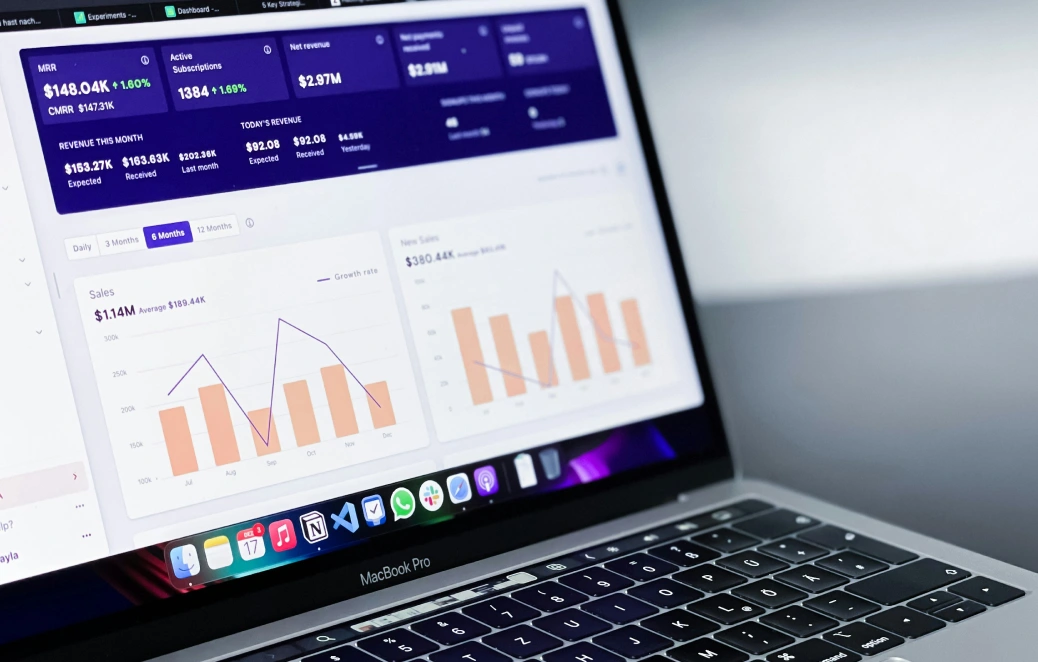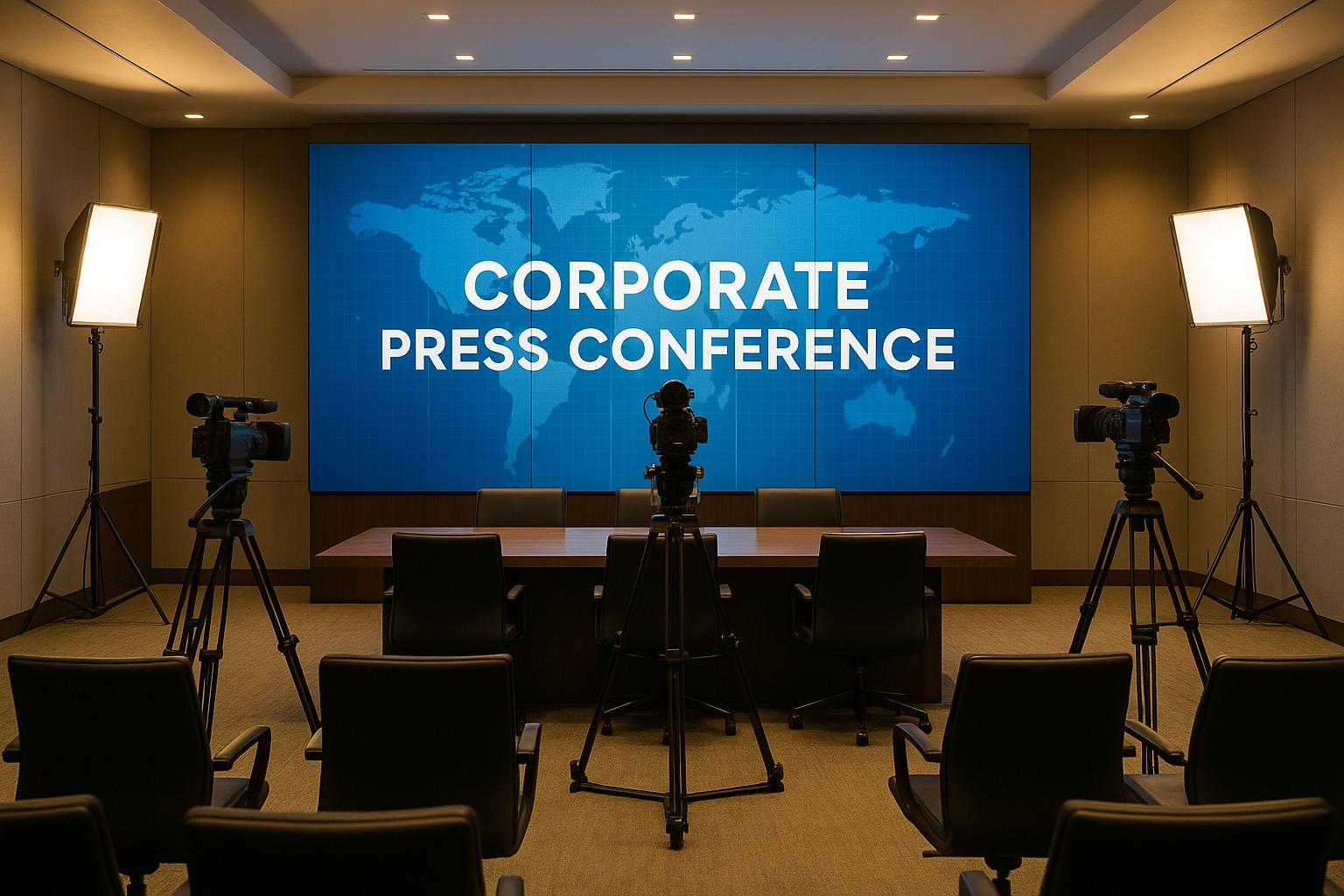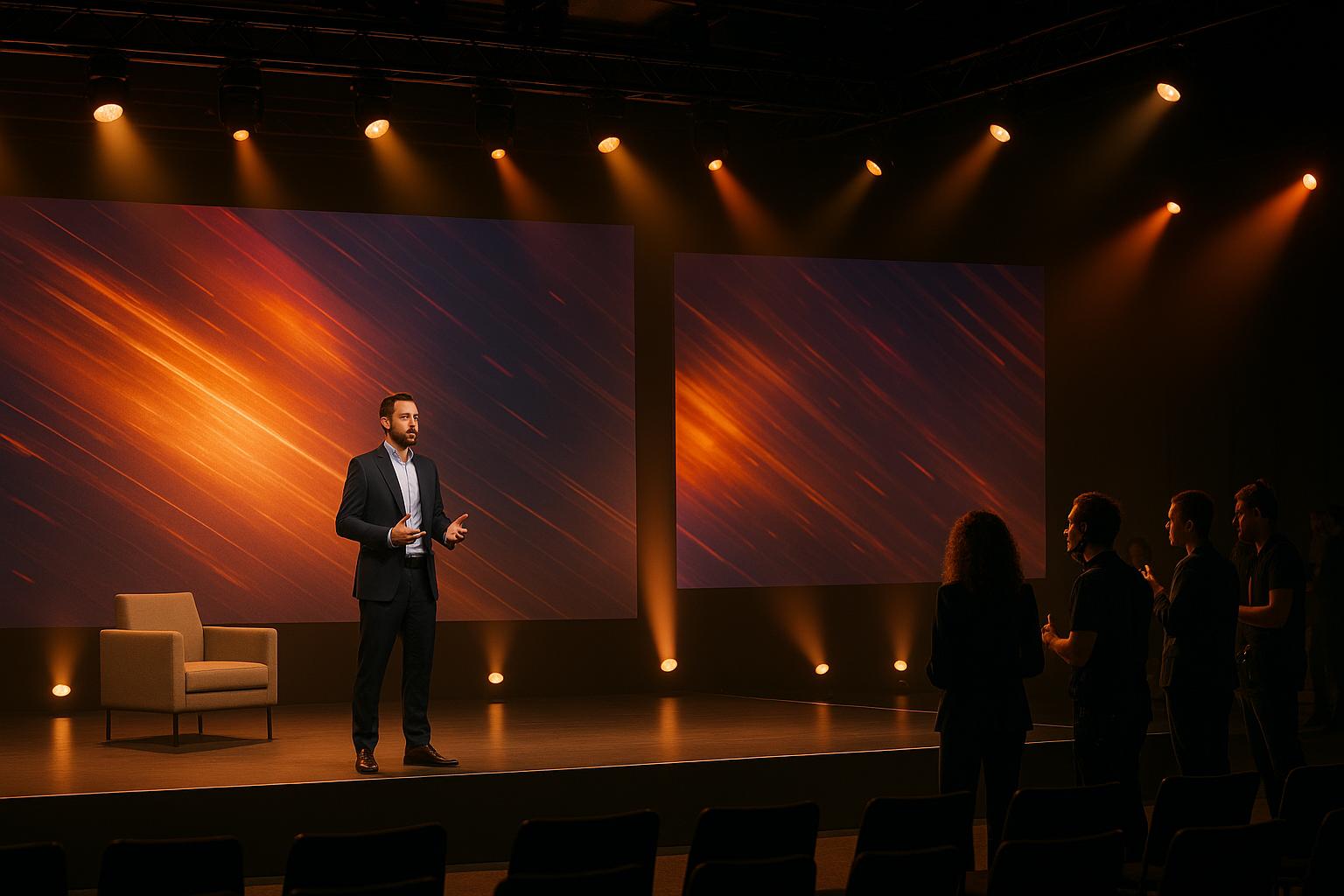4 Trends In Corporate Sales Meetings Coordination

Chief Executive Officer

Corporate sales meetings are evolving quickly, driven by changes in work environments, tighter budgets, and rising expectations. Here are four trends shaping how companies plan and execute these meetings:
- Advanced Audiovisual Technology: Tools like interactive displays, high-quality streaming, and automated setups are improving engagement, reducing technical issues, and saving time. These systems also support both hybrid and in-person meetings, cutting travel costs while maintaining professionalism.
- AI-Driven Event Coordination: AI tools simplify planning by automating tasks like scheduling, venue selection, and attendee management. They also personalize experiences through data insights, making meetings more relevant and engaging.
- Hybrid Meeting Formats: Combining in-person and virtual participation allows teams to connect across locations without large-scale travel. Hybrid meetings are flexible, cost-effective, and scalable for various event sizes.
- Personalized Engagement: Using attendee data, companies create tailored experiences with customized agendas, interactive tools, and mobile apps. This approach boosts participation and strengthens connections, leading to better outcomes.
These trends address modern challenges like remote collaboration, budget constraints, and the need for impactful meetings. By integrating smart technology and focusing on engagement, sales teams can deliver better results while optimizing resources.
4 event trends you MUST know in 2025
1. Using Advanced Audiovisual Technology
Today's sales meetings demand more than just the basics. Advanced audiovisual technology is reshaping the way teams connect, communicate, and collaborate during pivotal sales discussions. Tools like interactive displays and high-quality streaming equipment are no longer optional - they’re becoming essential for staying ahead in a competitive landscape.
This shift reflects evolving expectations from both internal teams and clients. Sales professionals now rely on seamless, reliable technology that enhances their presentations rather than causing frustrating disruptions.
Impact on Attendee Engagement
Interactive displays and immersive audio systems create a dynamic environment that keeps participants engaged. Features like touchscreen navigation allow sales teams to dive into proposals in real time, addressing client questions and concerns on the spot. Professional lighting setups also elevate video quality, making hybrid meetings more inclusive by ensuring remote attendees can clearly see facial expressions and body language.
Clear, high-quality audio is another game-changer. It eliminates the frustration of missed details due to sound issues, ensuring that everyone - whether in the room or dialing in remotely - can follow complex discussions without repeatedly asking for clarification.
Efficiency in Planning and Execution
Pre-configured AV setups save teams valuable time. With ready-to-go equipment, sales professionals can jump straight into their presentations without wasting time troubleshooting connection or feedback issues.
Integrated control systems simplify the process further. Coordinators can manage lighting, sound, and display settings from a single interface, cutting down on the need for multiple technicians and reducing delays during client meetings. Automated recording features also capture key discussions, freeing teams to focus on the conversation without worrying about missing important details.
These streamlined systems are adaptable to various meeting formats, making them a versatile solution for any sales scenario.
Scalability for Hybrid and In-Person Meetings
Modern AV technology is designed to seamlessly handle both hybrid and in-person meetings without requiring constant equipment overhauls. Flexible camera setups and wireless connectivity make it easy to adapt spaces for everything from small team huddles to large-scale client presentations.
Cloud-based tools also allow sales teams to access and share materials instantly, no matter where they are. This flexibility ensures that last-minute changes - like adding participants or switching locations - don’t derail important meetings.
Modular AV systems add another layer of adaptability. Companies can invest in solutions that expand as their needs grow, avoiding the expense of purchasing entirely separate systems for different meeting types.
Cost-Effectiveness for Corporate Budgets
While advanced AV systems may require an initial investment, they deliver long-term savings by reducing meeting delays, minimizing technical issues, and preventing lost sales opportunities. Reliable technology ensures smoother client presentations, which can make all the difference in closing deals.
Virtual and hybrid meeting capabilities also cut down on travel expenses. Sales teams can hold impactful client meetings without the costs and time associated with frequent travel, all while maintaining professional standards.
User-friendly equipment reduces the need for constant technical support, lowering associated costs. Additionally, energy-efficient designs and automated power management features help control operational expenses over time. These systems not only save money but also enhance overall performance, giving companies a competitive edge in their sales efforts.
2. Adding AI-Driven Event Coordination Tools
AI-powered coordination tools are transforming how meetings and events are planned, taking the process far beyond basic scheduling. These tools act as virtual assistants, handling everything from selecting the perfect venue to managing attendees in real time. They even learn from previous events to improve future planning. When paired with advanced audiovisual setups, these tools are reshaping how meetings are organized and executed.
Sales coordinators are discovering that AI can predict scheduling conflicts, recommend the best meeting times based on attendee preferences, and even suggest room layouts that align with the purpose of the event. This feedback-driven approach ensures that every meeting builds on the success of the last, creating a smarter planning process over time.
Efficiency in Planning and Execution
AI takes over repetitive coordination tasks, saving valuable time. Complex algorithms resolve scheduling conflicts in seconds and pinpoint ideal meeting times. Automated vendor comparison tools instantly evaluate catering options, equipment availability, and contract terms. With these routine tasks off their plate, planners can focus on more strategic activities, like crafting the agenda or engaging with stakeholders.
Even during the event, AI works behind the scenes, recalculating room capacities, updating catering needs, and notifying attendees of any last-minute changes - all in real time.
Impact on Attendee Engagement
AI helps create a more personalized experience for attendees by analyzing their profiles, participation history, and preferences. It can adjust seating arrangements, break schedules, and even tailor meeting content to ensure relevance for each participant. After the event, AI-generated follow-ups can highlight key discussion points and actionable items, making recaps more meaningful and engaging.
Scalability for Hybrid and In-Person Meetings
Hybrid events, where some attendees are in person and others join remotely, can be challenging to manage. AI simplifies this complexity by optimizing audiovisual setups and ensuring seamless communication between in-person and virtual participants. It also handles the logistics of large-scale events, such as coordinating schedules across multiple time zones and managing resources like space and staffing. Whether it’s a small team meeting or a large conference, AI ensures everything runs smoothly.
Cost-Effectiveness for Corporate Budgets
By automating repetitive tasks, AI reduces the need for manual oversight, cutting down on overhead costs. Predictive analytics prevent costly mistakes, like over-ordering catering or booking spaces that are too large, by providing accurate attendance forecasts and resource recommendations. Additionally, AI tools can compare vendor options and track pricing trends, leading to better deals and savings. Well-organized meetings not only save money but also improve productivity and strengthen client relationships, ultimately benefiting the company’s bottom line. Together with advanced AV tools, AI coordination systems provide a comprehensive solution for modern meeting needs.
3. Improving Hybrid and Flexible Meeting Formats
The rise of hybrid meeting formats has transformed the way corporate sales teams connect and collaborate. By blending in-person and virtual elements, these meetings offer the best of both worlds: maintaining personal connections while accommodating remote participants spread across different time zones. This evolution has reshaped how teams stay connected and streamlined the way meetings are planned and executed.
Efficiency in Planning and Execution
Hybrid meetings make logistical planning much simpler. Sales coordinators no longer need to juggle large venues or extensive travel arrangements. Instead, they can focus on crafting meaningful content and fostering engaging interactions. With virtual attendance, capacity limitations and last-minute changes become less of a headache. Modern tools, such as seamless screen sharing, collaborative document editing, and breakout sessions, ensure that everything from proposals to contract reviews and negotiations runs smoothly.
Impact on Attendee Engagement
Hybrid formats take engagement to a new level by combining digital tools with face-to-face interactions. Virtual attendees can actively participate through chat functions and digital polls, while those on-site enjoy the benefits of in-person networking during breaks. Interactive features, like real-time collaboration tools, keep everyone involved, regardless of their location. Plus, digital recordings and instant access to presentation materials ensure that the momentum continues even after the meeting wraps up.
Scalability for Hybrid and In-Person Meetings
One of the standout advantages of hybrid formats is their scalability. They can easily adapt to different group sizes and meeting objectives. For instance, a quarterly sales review might bring the core team together in person while regional managers join virtually. Similarly, training sessions can mix hands-on workshops for local attendees with remote learning for others. This flexibility allows sales teams to book smaller venues and adjust virtual capacity based on registration numbers, making the most of available resources.
Cost-Effectiveness for Corporate Budgets
Hybrid meetings aren’t just convenient - they’re also budget-friendly. In fact, event marketers now allocate 37% of their budgets to hybrid events, outpacing spending on purely in-person or virtual formats. By cutting down on travel expenses and broadening audience reach without increasing venue or catering costs, hybrid events deliver measurable savings. They also provide valuable data insights, allowing sales teams to track engagement metrics and follow-up actions to refine future events and demonstrate ROI. Interestingly, 61% of event professionals cite the interaction between virtual and in-person attendees as the top benefit of hybrid events - ranking even higher than cost savings. This enhanced interaction promotes networking and knowledge sharing, which ultimately leads to better sales results and stronger team collaboration.
sbb-itb-ae35a94
4. Boosting Attendee Engagement and Personalization
Corporate sales meetings have embraced a new era of personalized, data-driven experiences. This approach reshapes how sales coordinators plan content, deliver presentations, and evaluate success. By tapping into data analytics and advanced technology, meeting planners can craft experiences tailored to each attendee's unique interests and needs. When combined with cutting-edge AV and AI tools, this personalization becomes a cornerstone of modern meeting strategies.
Impact on Attendee Engagement
Personalized strategies, powered by advanced AV and AI tools, are transforming how attendees interact during sales meetings. Tailoring content to individual preferences has a direct impact on participation and engagement. Pre-event surveys and registration data enable coordinators to categorize attendees by their roles, experience levels, and interests. This segmentation allows for the creation of customized agendas, breakout sessions, and case studies that address the specific challenges of each group.
Interactive features are key to keeping attendees engaged. Tools like real-time polling, live Q&A sessions, and gamification elements ensure participants remain active rather than passive. Networking is also simplified with digital tools that allow attendees to share contact information instantly and schedule follow-up meetings based on shared goals or complementary skills.
Mobile event apps act as personalized hubs for attendees, offering tailored schedules, relevant resources, and networking suggestions. Push notifications provide timely updates on session changes or new opportunities, while in-app messaging helps connect individuals with similar interests or expertise.
Efficiency in Planning and Execution
Personalization doesn't just enhance the attendee experience - it also streamlines planning and execution. Real-time content adjustments allow presenters to tweak their materials on the fly, tailoring discussions to the audience's composition and engagement levels. Smart platforms can highlight the most relevant case studies or skip sections that aren't applicable, keeping sessions focused and impactful.
Automation is another game-changer. Tasks like seating arrangements, meal preferences, and session assignments can now be handled automatically, ensuring each attendee enjoys a seamless, customized experience from start to finish. These efficiencies save time, reduce manual effort, and enhance the overall quality of the event.
Cost-Effectiveness for Corporate Budgets
Personalized engagement strategies don't just improve experiences - they also deliver measurable financial benefits. Targeted content and networking opportunities lead to stronger connections and more actionable outcomes, driving a higher return on investment (ROI).
The use of data-driven insights provides clear metrics on attendee satisfaction, content effectiveness, and networking success. These insights help sales teams demonstrate the value of meetings to leadership and identify areas for improvement. By focusing on the most impactful personalization features, companies can allocate resources more strategically.
Additionally, personalized meetings reduce the need for extensive follow-up. When attendees leave with meaningful connections and actionable insights, there's less need for post-event nurturing to convert ideas into results. This streamlined process lowers sales cycle costs and accelerates deal closures, making personalization a win-win for both attendees and corporate budgets.
Comparison Table
Modern, tech-powered coordination has reshaped how corporate sales meetings are organized. Below is a table that breaks down the key differences between traditional methods and modern, trend-driven approaches, highlighting their benefits and challenges.
| Aspect | Traditional Approach | Modern Trend-Based Approach | Key Benefits | Implementation Challenges |
|---|---|---|---|---|
| Audiovisual Technology | Basic projectors, static presentations, manual setup | Interactive displays, wireless connectivity, automated systems, real-time content sharing | More engaging presentations and smoother operations | Higher upfront costs and staff training requirements |
| Event Coordination Tools | Spreadsheets, emails, paper sign-ups, and manual scheduling | AI-driven platforms with automated task management, predictive analytics, and centralized systems | Automation reduces errors, with 50% of planners projected to adopt AI by 2025 | Initial software costs, learning curve, and data integration challenges |
| Meeting Formats | In-person only, fixed agendas | Hybrid options with flexible scheduling and multi-location connectivity | Broader participation, better attendance, and cost savings | Requires investment in tech infrastructure and addressing diverse needs |
| Attendee Engagement | Generic content, limited interaction, post-event surveys only | Personalized experiences, real-time polling, and AI for matchmaking (used by 42% of planners) | Greater engagement and improved networking opportunities | Data collection complexity, privacy concerns, and content customization hurdles |
The table above provides a snapshot of how each approach influences meeting efficiency and costs. While traditional methods may seem cheaper upfront, they often come with hidden inefficiencies that can add up over time.
On the other hand, modern AI-driven coordination tools require a larger initial investment but deliver measurable returns. For instance, organizations adopting these tools report a 71% positive ROI, with 64% of business owners noting improvements in customer relationships and productivity.
Hybrid meeting formats also offer unique advantages. Although they demand investment in technology infrastructure, they frequently reduce travel and venue costs, expand audience reach, and generate more leads.
Personalization tools powered by AI take engagement to the next level by creating tailored experiences. Many business leaders believe this level of personalization will directly boost sales growth.
Traditional methods, while functional, often struggle to scale effectively. In contrast, modern solutions - though requiring careful planning - offer scalable, repeatable processes that improve over time through data insights and machine learning.
The choice between traditional and modern approaches ultimately depends on factors like meeting frequency, participant numbers, and how digitally advanced the organization is. Larger, more frequent events generally benefit from modern tools, while smaller, occasional gatherings may find traditional methods sufficient. These differences highlight why tech-driven coordination is becoming increasingly important for corporate sales meetings.
Conclusion
Corporate sales meetings are undergoing a transformation, driven by emerging trends like advanced AV technology, AI-powered tools, hybrid formats, and personalized experiences. These innovations are elevating how teams engage, collaborate, and connect. For instance, cutting-edge AV setups now enable interactive presentations that actively involve participants, while AI coordination tools streamline workflows and deliver measurable efficiencies. Hybrid meeting formats are bridging geographical gaps and cutting costs, and tailored attendee experiences are fostering deeper, more impactful connections.
Together, these trends tackle some of the biggest hurdles sales teams face today - tight budgets, dispersed teams, and the need to demonstrate clear results. Companies adopting these approaches are seeing noticeable boosts in participant satisfaction and overall business outcomes.
But here's the thing: success isn’t just about adopting new technology. It’s about implementing it thoughtfully. Integrating advanced audiovisual systems, AI platforms, hybrid meeting infrastructure, and personalization tools requires careful planning and specialized expertise. This is where expert partners like Corporate Optics come into play, offering end-to-end event planning, advanced AV production, and AI-driven solutions to ensure everything runs smoothly.
To truly maximize ROI and navigate the complexities of implementation, organizations need more than just the right tools - they need the right partnerships. As sales meetings continue to evolve, those who invest wisely in both technology and strategic support will be best equipped to achieve meaningful and lasting business growth.
FAQs
What steps can companies take to transition to hybrid meeting formats smoothly and avoid technical issues?
To make hybrid meetings run smoothly and avoid technical hiccups, companies need to prioritize dependable technology and thoughtful preparation. It starts with investing in top-notch audio systems, cameras, and displays tailored for hybrid setups. These tools are key to ensuring that both in-person and remote participants can communicate effectively and stay engaged.
Before the actual meeting, hold several tech rehearsals to check video streaming, sound quality, and internet stability. This proactive approach helps spot and fix any potential issues ahead of time. Incorporating smart room scheduling systems can also be a game-changer, preventing double bookings and making sure meeting spaces are used efficiently.
Equally important is clear communication with your team. Offer training sessions to familiarize everyone with the equipment and set clear guidelines for hybrid meeting etiquette. This ensures that all participants are on the same page and can contribute productively.
How can AI tools be used to make corporate sales meetings more engaging and personalized?
AI tools can play a game-changing role in making corporate sales meetings more engaging and tailored to your audience. By analyzing customer data, AI can help craft personalized content - like emails or presentations - that directly address the unique needs and priorities of each participant. During the meeting itself, AI can provide real-time insights, such as detecting emotional cues or gauging engagement levels, allowing you to adjust your approach on the fly for better communication. On top of that, predictive analytics can give you a head start by anticipating client needs and offering tailored recommendations that truly connect with them. Together, these strategies can make your meetings more focused, productive, and meaningful.
How does advanced audiovisual technology help reduce costs in corporate sales meetings?
Advanced audiovisual technology is a game-changer for corporate sales meetings, especially when it comes to cutting costs. By incorporating hybrid meeting formats, businesses can allow some participants to join virtually. This approach slashes expenses tied to travel, lodging, and large venue bookings.
On top of that, tools like virtual sets and augmented reality bring immersive, lifelike environments to the table - without needing a physical space. This not only saves time and money but also simplifies the planning process while elevating the overall experience for everyone involved.
Related Blog Posts









